2018年高考英语作文写作指南:高考英语作文应用文便条写法和范文
- 格式:doc
- 大小:303.50 KB
- 文档页数:2
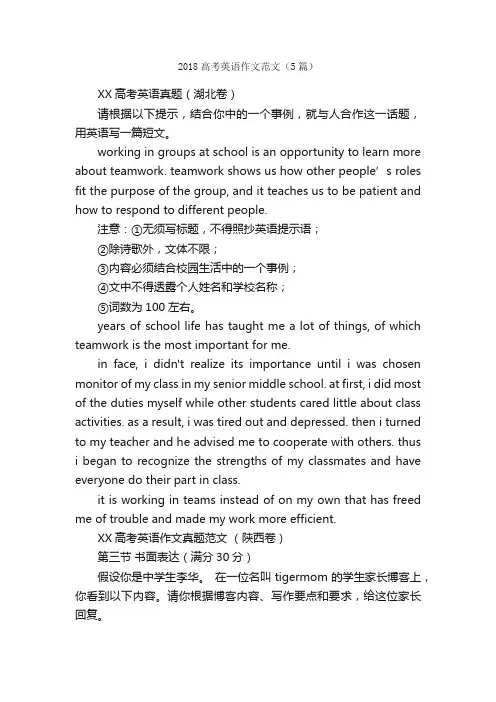
2018高考英语作文范文(5篇)XX高考英语真题(湖北卷)请根据以下提示,结合你中的一个事例,就与人合作这一话题,用英语写一篇短文。
working in groups at school is an opportunity to learn more about teamwork. teamwork shows us how other people’s roles fit the purpose of the group, and it teaches us to be patient and how to respond to different people.注意:①无须写标题,不得照抄英语提示语;②除诗歌外,文体不限;③内容必须结合校园生活中的一个事例;④文中不得透露个人姓名和学校名称;⑤词数为100左右。
years of school life has taught me a lot of things, of which teamwork is the most important for me.in face, i didn't realize its importance until i was chosen monitor of my class in my senior middle school. at first, i did most of the duties myself while other students cared little about class activities. as a result, i was tired out and depressed. then i turned to my teacher and he advised me to cooperate with others. thus i began to recognize the strengths of my classmates and have everyone do their part in class.it is working in teams instead of on my own that has freed me of trouble and made my work more efficient.XX高考英语作文真题范文(陕西卷)第三节书面表达(满分30分)假设你是中学生李华。

英语应用文写作范文 高考英语应用文写作包括哪些类型,下文是小编整理的英语应用文;写作类型及范文,仅供大家参考。
英语应用文写作1.便条明天是Alice的生日,她准备举行一个生日聚会并邀请Kate参加,但Kate不得不待在家里照顾生病的妈妈。
假如你是Kate,请写张便条,让人带给Alice。
【参考范文】Dear Alice,Thank you for inviting me to take part in your birthday party. I’d like to come, but my mother is ill. I have to stay at home to look after her. So I can’t come. Happy birthday to you!Yours,Kate2.通知加拿大着名专家(expert)Jim Green将于本周日来我校作演讲,演讲主题是“Saving Our Earth”,假如你是校学生会主席,请写则通知,告诉全校同学。
时间:上午9:00地点:学校礼堂要求:带好笔记本并做好笔记;保持会场安静,不要乱扔垃圾。
【参考范文】NOTICEBoys and girls,An expert called Jim Green from Canada will come to our school this Sunday. He will give a report on“Saving Our Earth”. The report will start in our school hall at 9:00 in the morning. Remember to bring your notebooks. Please keep quiet and don’t throw rubbish about.That’all. Thank you.3.电话留言下面是一则电话留言,请根据留言内容,编一段50词左右的对话。
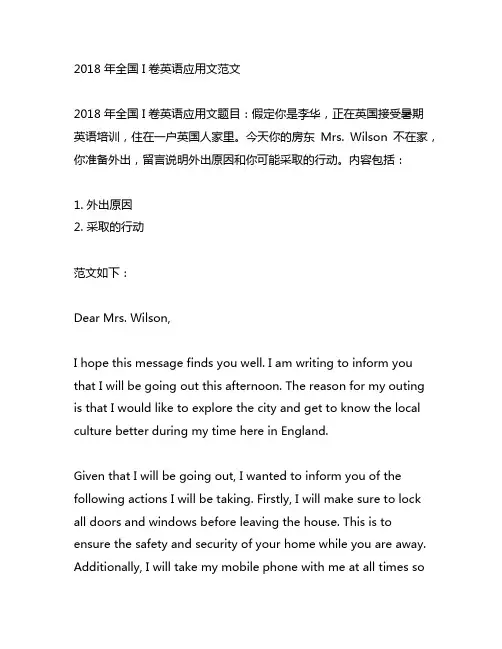
2018 年全国 I 卷英语应用文范文2018 年全国 I 卷英语应用文题目:假定你是李华,正在英国接受暑期英语培训,住在一户英国人家里。
今天你的房东Mrs. Wilson 不在家,你准备外出,留言说明外出原因和你可能采取的行动。
内容包括:1. 外出原因2. 采取的行动范文如下:Dear Mrs. Wilson,I hope this message finds you well. I am writing to inform you that I will be going out this afternoon. The reason for my outing is that I would like to explore the city and get to know the local culture better during my time here in England.Given that I will be going out, I wanted to inform you of the following actions I will be taking. Firstly, I will make sure to lock all doors and windows before leaving the house. This is to ensure the safety and security of your home while you are away. Additionally, I will take my mobile phone with me at all times sothat I can stay in touch with you in case of any emergencies. I will also carry a map and the address of the house with me in case I get lost and need to find my way back. Lastly, I will make sure to be back at a reasonable hour to respect the house rules and your privacy.I hope these plans will assure you that I will be responsible and cautious during my time out. If you have any additional instructions or concerns, please do not hesitate to leave me a message or call me on my mobile phone. Thank you for your understanding, and I look forward to sharing my experiences with you when I return.Yours sincerely,Li Hua以上为一篇 2018 年全国 I 卷英语应用文范文,范文以非 Markdown 格式的普通文本撰写,总字数为 328 字。
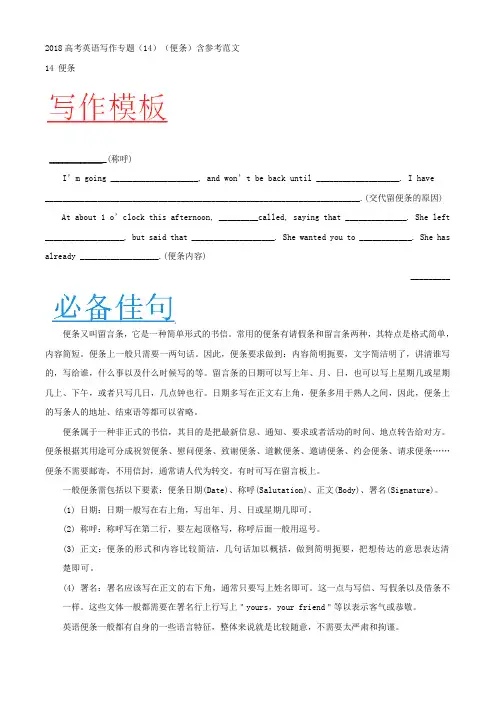
2018高考英语写作专题(14)(便条)含参考范文14 便条_____________(称呼)I’m going ____________________, and won’t be back until ___________________. I have________________________________________________________________________.(交代留便条的原因) At about 1 o’clo ck this afternoon, _________called, saying that ______________. She left __________________, but said that ___________________. She wanted you to ____________. She has already __________________.(便条内容)_________便条又叫留言条,它是一种简单形式的书信。
常用的便条有请假条和留言条两种,其特点是格式简单,内容简短。
便条上一般只需要一两句话。
因此,便条要求做到:内容简明扼要,文字简洁明了,讲清谁写的,写给谁,什么事以及什么时候写的等。
留言条的日期可以写上年、月、日,也可以写上星期几或星期几上、下午,或者只写几日,几点钟也行。
日期多写在正文右上角,便条多用于熟人之间,因此,便条上的写条人的地址、结束语等都可以省略。
便条属于一种非正式的书信,其目的是把最新信息、通知、要求或者活动的时间、地点转告给对方。
便条根据其用途可分成祝贺便条、慰问便条、致谢便条、道歉便条、邀请便条、约会便条、请求便条……便条不需要邮寄,不用信封,通常请人代为转交。
有时可写在留言板上。
一般便条需包括以下要素:便条日期(Date)、称呼(Salutation)、正文(Body)、署名(Signature)。
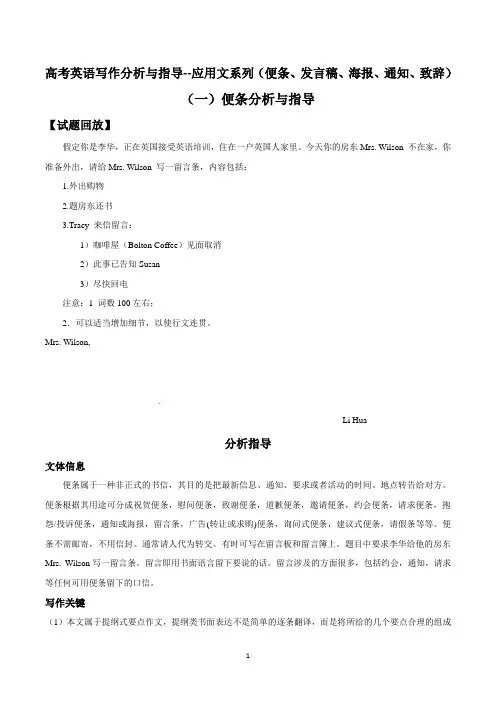
高考英语写作分析与指导--应用文系列(便条、发言稿、海报、通知、致辞)(一)便条分析与指导【试题回放】假定你是李华,正在英国接受英语培训,住在一户英国人家里。
今天你的房东Mrs. Wilson 不在家,你准备外出,请给Mrs. Wilson 写一留言条,内容包括:1.外出购物2.题房东还书3.Tracy 来信留言:1)咖啡屋(Bolton Coffee)见面取消2)此事已告知Susan3)尽快回电注意:1 词数100左右;2.可以适当增加细节,以使行文连贯。
Mrs. Wilson,________________________________________________________________________________________ ____________________________________________________________________________________________ __________________________.Li Hua分析指导文体信息便条属于一种非正式的书信,其目的是把最新信息、通知、要求或者活动的时间、地点转告给对方。
便条根据其用途可分成祝贺便条,慰问便条,致谢便条,道歉便条,邀请便条,约会便条,请求便条,抱怨/投诉便条,通知或海报,留言条,广告(转让或求购)便条,询问式便条,建议式便条,请假条等等。
便条不需邮寄,不用信封。
通常请人代为转交。
有时可写在留言板和留言簿上。
题目中要求李华给他的房东Mrs. Wilson写一留言条。
留言即用书面语言留下要说的话。
留言涉及的方面很多,包括约会,通知,请求等任何可用便条留下的口信。
写作关键(1)本文属于提纲式要点作文,提纲类书面表达不是简单的逐条翻译,而是将所给的几个要点合理的组成比较通顺的语句,因此要仔细组织语言,合理安排结构。
(2)正确使用人称与时态。
便条所使用的人称与时态不很固定,写作时要根据情景和人物关系正确选择人称与时态。
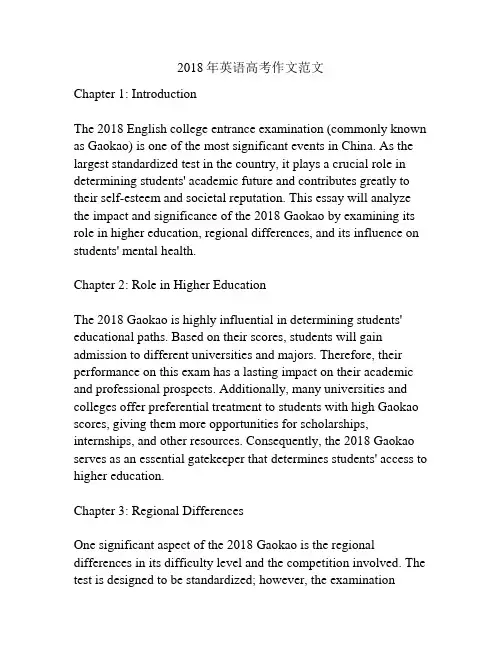
2018年英语高考作文范文Chapter 1: IntroductionThe 2018 English college entrance examination (commonly known as Gaokao) is one of the most significant events in China. As the largest standardized test in the country, it plays a crucial role in determining students' academic future and contributes greatly to their self-esteem and societal reputation. This essay will analyze the impact and significance of the 2018 Gaokao by examining its role in higher education, regional differences, and its influence on students' mental health.Chapter 2: Role in Higher EducationThe 2018 Gaokao is highly influential in determining students' educational paths. Based on their scores, students will gain admission to different universities and majors. Therefore, their performance on this exam has a lasting impact on their academic and professional prospects. Additionally, many universities and colleges offer preferential treatment to students with high Gaokao scores, giving them more opportunities for scholarships, internships, and other resources. Consequently, the 2018 Gaokao serves as an essential gatekeeper that determines students' access to higher education.Chapter 3: Regional DifferencesOne significant aspect of the 2018 Gaokao is the regional differences in its difficulty level and the competition involved. The test is designed to be standardized; however, the examinationpapers vary across different provinces, leading to unequal opportunities for students in different regions. Students from developed regions, such as Beijing and Shanghai, often face more fierce competition and higher cut-off scores. In contrast, students from less developed regions may have a comparatively easier exam and lower cut-off scores. This regional disparity raises concerns about fairness and equal opportunities for all students.Chapter 4: Influence on Students' Mental HealthThe pressure imposed by the 2018 Gaokao is immense and has significant impacts on students' mental health. The year leading up to the exam is filled with intensive study and high expectations from parents, teachers, and society. The fear of failure and the high-stakes nature of the exam can cause extreme stress and anxiety among students. This pressure may lead to burnout, depression, and even suicidal thoughts. Therefore, it is crucial for both educators and parents to provide support and create a healthy study environment to ensure students' mental well-being. ConclusionIn conclusion, the 2018 Gaokao plays a central role in determining students' educational and professional paths. It influences not only their future but also their mental health. The exam showcases regional differences in its difficulty levels, which raises concerns about fairness and equal opportunities. Thus, it is essential for policymakers to address these issues and ensure that the 2018 Gaokao provides a fair and supportive environment for students, allowing them to pursue their dreams while maintaining theirmental well-being.Chapter 5: Strategies for Success in the GaokaoGiven the significant impact of the 2018 Gaokao, students need to develop effective strategies to prepare themselves for success. Here are some key strategies that can help students navigate this challenging exam:1. Comprehensive Study Plan: Students should create a study plan that covers all the subjects tested in the Gaokao. This plan should allocate sufficient time for each subject, focusing on strengthening weak areas and building a strong foundation. A well-structured study plan will help students stay organized and ensure they cover all the necessary material.2. Mock Exams and Practice Papers: Practicing with mock exams and past papers is crucial to familiarize students with the exam format and improve their speed and accuracy. Time management is essential during the Gaokao, and regular practice will help students become more comfortable with the time constraints and pressure of the actual exam.3. Seek Help and Guidance: Students should not hesitate to seek help from their teachers, peers, or online resources. Discussing difficult concepts and clarifying doubts will enhance their understanding and increase their chances of scoring well. Additionally, joining study groups or finding a study partner can provide support, motivation, and accountability.4. Balance Study and Rest: While intensive studying is necessary, it is equally important to take regular breaks and get enough rest. Awell-rested mind is more focused, productive, and better able to retain information. Maintaining a healthy balance between study and leisure activities will prevent burnout and enhance overall performance.5. Manage Stress and Emotions: The Gaokao can be highly stressful, leading to feelings of anxiety and self-doubt. It is essential for students to develop healthy coping mechanisms, such as exercise, meditation, or talking to a trusted confidant. Managing stress will help students maintain a clear mind and perform to the best of their abilities.6. Stay Updated with Current Affairs: The Gaokao often includes questions about current events and societal issues. Students should make an effort to stay updated with current affairs by reading newspapers, watching the news, or following reliable online sources. This knowledge will not only enhance their performance in the exam but also develop their overall awareness and critical thinking skills.7. Positive Mindset: Maintaining a positive mindset is crucial during the Gaokao. Believing in oneself, focusing on strengths, and setting realistic goals will help students overcome challenges and perform at their best. Encouragement from parents, teachers, and mentors can significantly impact students' confidence and motivation.In conclusion, effective study strategies are crucial for success in the 2018 Gaokao. Developing a comprehensive study plan, practicing with mock exams, seeking help and guidance,maintaining a balance between study and rest, managing stress and emotions, staying updated with current affairs, and cultivating a positive mindset are key factors that can help students excel in this high-stakes exam. Emphasizing these strategies and providing support to students will contribute to a more successful and well-rounded Gaokao experience.。
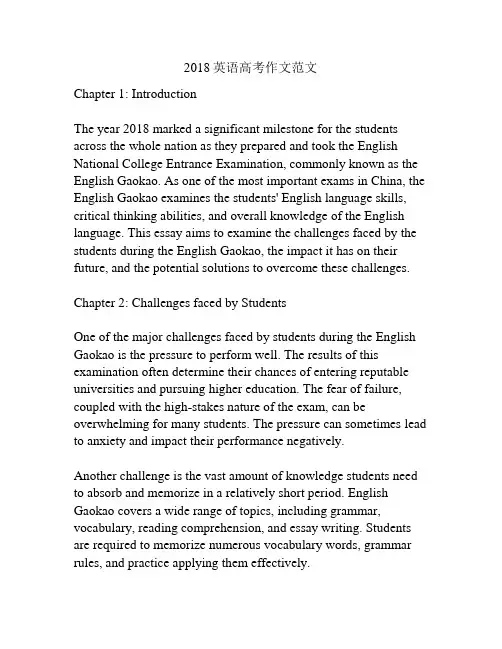
2018英语高考作文范文Chapter 1: IntroductionThe year 2018 marked a significant milestone for the students across the whole nation as they prepared and took the English National College Entrance Examination, commonly known as the English Gaokao. As one of the most important exams in China, the English Gaokao examines the students' English language skills, critical thinking abilities, and overall knowledge of the English language. This essay aims to examine the challenges faced by the students during the English Gaokao, the impact it has on their future, and the potential solutions to overcome these challenges.Chapter 2: Challenges faced by StudentsOne of the major challenges faced by students during the English Gaokao is the pressure to perform well. The results of this examination often determine their chances of entering reputable universities and pursuing higher education. The fear of failure, coupled with the high-stakes nature of the exam, can be overwhelming for many students. The pressure can sometimes lead to anxiety and impact their performance negatively.Another challenge is the vast amount of knowledge students need to absorb and memorize in a relatively short period. English Gaokao covers a wide range of topics, including grammar, vocabulary, reading comprehension, and essay writing. Students are required to memorize numerous vocabulary words, grammar rules, and practice applying them effectively.Chapter 3: Impact on Students' FutureThe English Gaokao has a significant impact on students' future prospects. The grades obtained in this exam are used by universities to evaluate and select their incoming students. Higher scores in the Gaokao can open doors to prestigious universities, increase scholarship opportunities and enhance future job prospects. Consequently, the pressure to excel in this exam often leads to highly competitive environments among students, where only a limited number can succeed.Moreover, the English Gaokao plays a crucial role in determining the quality of English education in China. As this examination tests various aspects of the English language, it acts as a benchmark to evaluate the efficacy of the English language curriculum across the nation. The results provide feedback on the effectiveness of teaching methods, highlight areas for improvement, and inform the development of future educational policies.Chapter 4: Potential SolutionsTo address the challenges faced by students during the English Gaokao, it is crucial to emphasize the importance of a well-balanced approach to education. Students should be encouraged to take care of their mental and physical well-being, as excessive pressure and stress can hinder their performance. Schools can provide counseling services, stress management workshops, and encourage extracurricular activities to create a more holistic learning environment.Additionally, the educational system should promote a more student-centered approach, focusing on enhancing critical thinking and problem-solving abilities rather than rote memorization. Incorporating interactive and practical teaching methods can help create a dynamic and engaging classroom environment. Teachers might consider utilizing multimedia tools, group discussions, and project-based assignments to foster the students' love for the subject and encourage active participation.In conclusion, the English Gaokao presents several challenges for students, impacts their future prospects, and influences the quality of English education in China. By recognizing the pressures involved, implementing a balanced approach, and promoting a student-centered learning environment, the educational system can support students in preparing for this high-stakes examination while ensuring their overall growth and development. This will help to mitigate the challenges faced by students and provide them with a brighter future.Chapter 5: The Importance of Language ProficiencyOne of the key aspects that the English Gaokao assesses is the students' language proficiency. English has become a global language, and proficiency in this language has become increasingly important in various fields such as business, academia, and technology. A high level of English proficiency can open doors to international opportunities and enhance global communication skills.Therefore, it is essential for students to develop strong language skills that go beyond simply passing a test. The English Gaokaoshould not be seen as just a means to an end, but rather as an opportunity to improve one's language skills for future success. Students should understand the real-life application of the language and strive to become proficient English speakers and writers.Chapter 6: Adapting to the Changing LandscapeIn recent years, there have been discussions about reforming the English Gaokao to better align with practical language skills and critical thinking abilities. The focus is shifting from pure memorization of vocabulary and grammar rules to more practical applications of the language. This change not only benefits the students but also creates a more accurate evaluation of their language proficiency.Furthermore, with the advancements in technology, there is a growing emphasis on incorporating digital tools and resources into language learning. Online platforms, mobile applications, and artificial intelligence-based programs can enhance students' language learning experiences and make them more interactive and engaging. These tools can provide personalized feedback, practice exercises, and real-time assessment, allowing students to track their progress and improve their language skills effectively. Chapter 7: Collaboration between StakeholdersTo overcome the challenges faced by students during the English Gaokao, collaboration between various stakeholders is crucial. This includes educators, policymakers, parents, and students themselves. Educators should strive to develop innovative teachingstrategies that promote effective language learning and critical thinking. Policymakers should consider the recommendations of educators and students when devising educational policies and conducting Gaokao reforms.Parents play a vital role in supporting students' learning journey. They should understand the challenges faced by their children and provide guidance and encouragement. Parents can also play an active role in advocating for a more holistic and student-centered approach to education.Chapter 8: ConclusionThe English Gaokao is an important examination that has a significant impact on the students' future prospects and the quality of English education in China. However, it is essential to recognize the challenges students face and provide support to help them excel in this examination while maintaining their overall well-being.Implementing a balanced approach that values mental and physical health, promoting a student-centered learning environment, and adapting the examination format to assess practical language skills will contribute to a more comprehensive and effective English Gaokao experience. Collaboration between stakeholders is essential to bring about these changes and ensure that students are well-prepared for their future endeavors.By addressing the challenges, nurturing language proficiency, adapting to changes, and fostering collaboration, the English Gaokao can become a more accurate measure of students' languageskills and a stepping stone towards a brighter future. With these improvements, students will be better equipped to face the globalized world and pursue their academic and career aspirations successfully.。
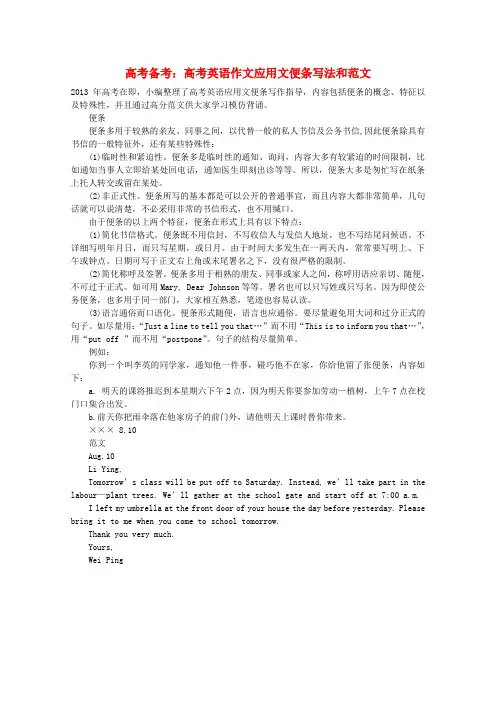
高考备考:高考英语作文应用文便条写法和范文2013年高考在即,小编整理了高考英语应用文便条写作指导,内容包括便条的概念、特征以及特殊性,并且通过高分范文供大家学习模仿背诵。
便条便条多用于较熟的亲友、同事之间,以代替一般的私人书信及公务书信,因此便条除具有书信的一般特征外,还有某些特殊性:(1)临时性和紧迫性。
便条多是临时性的通知、询问,内容大多有较紧迫的时间限制,比如通知当事人立即给某处回电话,通知医生即刻出诊等等。
所以,便条大多是匆忙写在纸条上托人转交或留在某处。
(2)非正式性。
便条所写的基本都是可以公开的普通事宜,而且内容大都非常简单,几句话就可以说清楚,不必采用非常的书信形式,也不用缄口。
由于便条的以上两个特征,便条在形式上具有以下特点:(1)简化书信格式。
便条既不用信封,不写收信人与发信人地址,也不写结尾问候语。
不详细写明年月日,而只写星期,或日月。
由于时间大多发生在一两天内,常常要写明上、下午或钟点。
日期可写于正文右上角或末尾署名之下,没有很严格的限制。
(2)简化称呼及签署。
便条多用于相熟的朋友、同事或家人之间,称呼用语应亲切、随便,不可过于正式。
如可用Mary, Dear Johnson等等。
署名也可以只写姓或只写名。
因为即使公务便条,也多用于同一部门,大家相互熟悉,笔迹也容易认读。
(3)语言通俗而口语化。
便条形式随便,语言也应通俗。
要尽量避免用大词和过分正式的句子。
如尽量用:“Just a line to tell you that…”而不用“This is to inform you that…”,用“put off ”而不用“postpone”。
句子的结构尽量简单。
例如:你到一个叫李英的同学家,通知他一件事,碰巧他不在家,你给他留了张便条,内容如下:a. 明天的课将推迟到本星期六下午2点,因为明天你要参加劳动—植树,上午7点在校门口集合出发。
b.前天你把雨伞落在他家房子的前门外,请他明天上课时替你带来。
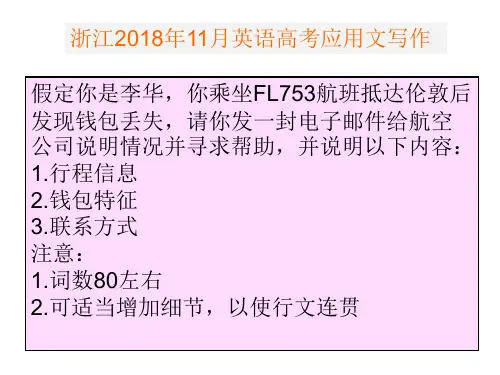

【2018·浙江卷·第一节】应用文写作假定你是李华,你校英语协会招聘志愿者,接待来访的国外中学生。
请你写信应聘,内容包括:1. 口语能力:2. 相关经验;3. 应聘目的。
注意:1. 词数80左右;2. 可以适当增加细节,以使行文连贯。
【解析】本篇书面表达属于应用文,要求写应聘信。
【满分范文】Dear Sir or Madam,My name is Li Hua. And I am writing to apply for being a volunteer of our school English association.I have a good command of English and have been to the USA twice. So I can communicate well with native speakers of English. What’s more, I am kind and friendly to other people. So I can easily get along with foreign students.I’m particularly interested in this job because I want to further improve my oral English capabilities and interpersonal communication skills.Hopefully I can receive your acceptance.Yours faithfully,Li Hua【2018·天津卷】假设你是晨光中学的机器人兴趣小组组长李津,你的美国朋友Chris就读于天津某国际学校,他曾在机器人技能竞赛中获奖。
你打算邀请他加入你的团队,参加即将于7月底在天津举行的世界青少学机器人技能竞赛。
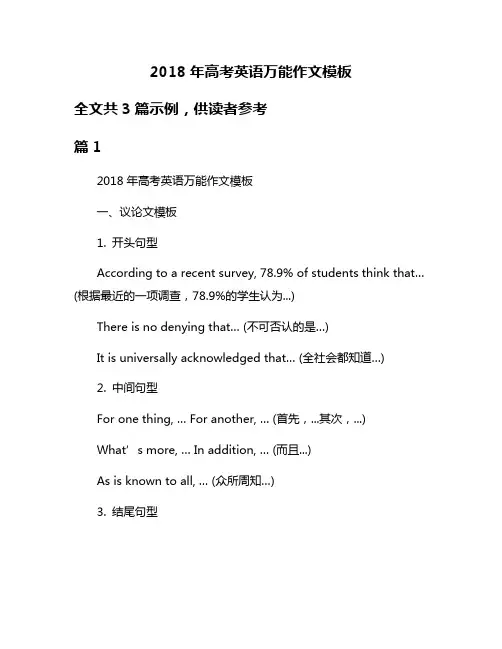
2018年高考英语万能作文模板全文共3篇示例,供读者参考篇12018年高考英语万能作文模板一、议论文模板1. 开头句型According to a recent survey, 78.9% of students think that… (根据最近的一项调查,78.9%的学生认为...)There is no denying that… (不可否认的是…)It is universally acknowledged that… (全社会都知道…)2. 中间句型For one thing, … For another, … (首先,...其次,...)What’s more, … In addition, … (而且...)As is known to all, … (众所周知…)3. 结尾句型Taking all these factors into consideration, we may come to the conclusion that… (把所有这些因素考虑在内,我们可能会得出这样的结论...)Therefore, it goes without saying that… (因此,不言而喻...)From what has been discussed above, we may reasonably arrive at the conclusion that… (通过以上讨论,我们可以得出合理的结论...)二、记叙文模板1. 开头句型Once upon a time, there was… (从前,有一个...)It was a sunny day when… (那是一个阳光明媚的日子...)2. 中间句型From then on, … (从那时起...)Mingled with these feelings was the desire to… (与这些感受交织在一起的是...)To our astonishment, … (令我们惊讶的是...)3. 结尾句型Looking back on the experience,… (回顾这次经历,...)As the years pass, I believe that… (随着时间的流逝,我相信...)All in all, the key to success is… (总的来说,成功的关键是...)三、应用文模板1. 开头句型We are very pleased to inform you that… (我们很高兴地通知您…)In response to your request for more information, please find enclosed… (为了回应您对更多信息的要求,请参阅附件…)2. 中间句型We are glad to inform you that… (我们很高兴地告诉您…)Further to our meeting yesterday, I am writing to confirm… (关于昨天我们的会议,我在此确认...)The purp ose of my writing is to… (我写信的目的是...)3. 结尾句型Should you have any further questions, please do not hesitate to contact me. (如有任何进一步的问题,请随时联系我。
2018年高考英语作文范文As the 2018 English national college entrance examination approaches, students across the country are preparing for the English writing test. The writing test is an important part of the English exam, and it requires students to demonstrate their language proficiency and writing skills. In this article, we will provide a sample essay for the 2018 English writing test, along with some tips and strategies for writing a successful essay.Sample Essay:Title: The Impact of Technology on Education。
In today's digital age, technology has become an integral part of our daily lives, and its impact on education is undeniable. With the advent of the internet, students now have access to a wealth of information at their fingertips, and this has revolutionized the way we learn and acquire knowledge. However, the widespread use of technology in education has also raised concerns about its potential negative effects. In this essay, we will explore the impact of technology on education and discuss its implications for the future.First and foremost, technology has greatly expanded the learning opportunities available to students. Through online resources, students can access a wide range of educational materials, including textbooks, research papers, and educational videos. This has made learning more accessible and convenient, allowing students to study at their own pace and explore topics that interest them. Furthermore, technology has also facilitated communication and collaboration among students and teachers, enabling them to exchange ideas and work together on projects regardless of their physical location.On the other hand, the overreliance on technology in education has raised concerns about the potential negative effects it may have on students. With the increasing use of computers and mobile devices in the classroom, there is a growing concern that students may become too dependent on technology for their learning, leading to a decline incritical thinking and analytical skills. Moreover, the constant exposure to digital devices may also have adverse effects on students' health, such as eye strain and poor posture.In conclusion, the impact of technology on education is a double-edged sword. While it has greatly expanded learning opportunities and facilitated communication and collaboration, it also raises concerns about the potential negative effects on students' learning and health. As we move forward, it is important to strike a balance between the use of technology and traditional teaching methods, and to ensure that students are equipped with the necessary skills to thrive in an increasingly digital world.Tips for Writing a Successful Essay:1. Start with a clear and concise introduction that introduces the topic and provides an overview of the main points you will discuss in the essay.2. Use specific examples and evidence to support your points, and avoid making generalizations or unsupported claims.3. Organize your essay in a logical and coherent manner, with each paragraph focusing on a specific aspect of the topic.4. Use a variety of sentence structures and vocabulary to make your writing more engaging and sophisticated.5. Conclude your essay by summarizing the main points and reiterating your stance on the topic.By following these tips and using the sample essay as a reference, students can improve their writing skills and prepare for the English writing test in the 2018 national college entrance examination. Good luck!。
2018年高考英语万能作文模板English:In the 2018 high school English exam, one possible essay topic could be the importance of environmental protection. Students could discuss how environmental issues, such as pollution and climate change, impact society and the planet as a whole. They could also delve into the various ways in which individuals and governments can work together to combat these issues, whether it be through adopting sustainable practices or implementing stricter regulations. The essay could also explore the consequences of failing to address these environmental problems and emphasize the urgency of taking action. By providing specific examples and presenting well-reasoned arguments, students can convey a strong message on the significance of environmental protection.中文翻译:在2018年高考英语考试中,可能的作文题目之一是环保的重要性。
题目:假设你是李华,你的新西兰朋友Terry 将去中国朋友家里做客,发邮件向你咨询相关民俗。
请你回复邮件,内容包含:1、到达时间2、适合的礼物3、餐桌礼仪范文:Dear Terry,How are you doing? In your last letter, you asked me about being a guest to a Chinese friend ’homes. Now, I am wri ting to inform you of some relevant details.To begin with,according to our tradition, you are supposed to arrive early, so that you can help the family prepare thedinner, which is not only meaningful but also interesting. Besides, you’ dbetter bring some gifts, such as a book or a Chinese knot. What ’more,s when you are enjoying the meal, you need to avoid making noises while chewing food.Hopefully, these suggestions would be helpful for you. I have the confidence that you will have a great time. I am loo king forward to your good news.Best wishes!Yours,LiHua题目:你受学生会拜托为校宣传栏“英语天地”写一则通知,请大家观看一部英文短片Growing Together ,内容包含:1、短片内容:学校的发展;2、放映时间、地点;3、欢迎对短片提出建议。
2018浙江高考英语作文范文Chapter 1: IntroductionThe Zhejiang College Entrance Examination (commonly known as the "高考") is an important milestone in the educational career of Chinese high school students. In 2018, the English section of the Zhejiang College Entrance Examination posed a significant challenge to students. This paper aims to provide an analysis and evaluation of the essay section of the 2018 Zhejiang College Entrance Examination, focusing on the difficulty level, the topics, and the overall performance of the students.Chapter 2: Difficulty LevelThe difficulty level of the English essay section in the 2018 Zhejiang College Entrance Examination was higher compared to previous years. The topics were complex and required students to think critically and express themselves effectively. The essay questions focused on social issues, current events, and personal experiences. For instance, one topic required students to discuss the impact of social media on teenagers' lives. To answer such questions adequately, students needed to possess a strong command of the English language, as well as analytical and writing skills.Chapter 3: TopicsThe topics selected for the essay section of the 2018 Zhejiang College Entrance Examination were diverse and relevant to students' lives. They ranged from environmental issues to culturalheritage, from technological advancements to personal growth. This allowed students to showcase their knowledge and understanding of various subjects. The topics also encouraged students to think critically and express their opinions, fostering creativity and originality in their writing.Chapter 4: Students' PerformanceOverall, the students' performance in the essay section of the 2018 Zhejiang College Entrance Examination was commendable. Many students exhibited strong language skills and the ability to convey their thoughts clearly and effectively. They demonstrated a high level of coherence and organization in their writing, presenting arguments and supporting them with relevant examples and evidence. However, there were still some areas for improvement. Some students struggled with grammar and vocabulary, leading to occasional errors and lack of clarity in their writing. Additionally, a small number of students faced difficulties in time management, resulting in rushed and incomplete essays.ConclusionIn conclusion, the 2018 Zhejiang College Entrance Examination English essay section presented a challenging yet stimulating opportunity for students to showcase their language skills and critical thinking abilities. The difficulty level of the questions reflected the need for students to possess a strong command of the English language and the capacity to express their thoughts effectively. The topics selected were broad, diverse and relevant, offering students an opportunity to engage with subjects that areimportant in today's world. The overall performance of the students was impressive, although there were areas that require attention and improvement. The English essay section of the 2018 Zhejiang College Entrance Examination served as a platform for students to demonstrate their academic prowess and preparedness for future academic endeavors.Chapter 5: Implications for English EducationThe difficulty level and topic selection of the English essay section in the 2018 Zhejiang College Entrance Examination have important implications for English education in China. The challenging nature of the questions suggests that English language proficiency should be a priority in classrooms. Teachers should focus on developing students' vocabulary, grammar, and writing skills to enable them to effectively express their thoughts and ideas.Furthermore, the diverse and relevant topics of the essay section highlight the need for a well-rounded English curriculum. English education should not only focus on language proficiency but also on developing students' critical thinking skills and their ability to engage with real-world issues. Teachers should incorporate current events, social issues, and personal growth topics in their lessons to encourage students to think critically and express their opinions in English.Chapter 6: Recommendations for StudentsBased on the analysis of the 2018 Zhejiang College Entrance Examination, there are several recommendations for students to improve their performance in the essay section.Firstly, students should strive to improve their language proficiency. This includes expanding their vocabulary, improving grammar usage, and practicing writing regularly. Engaging in reading English materials, both fiction and non-fiction, can greatly enhance language skills and expose students to different writing styles and techniques.Secondly, students should develop their critical thinking and analytical skills. This can be done by actively participating in class discussions, debates, and engaging with current events and social issues outside of the classroom. Being able to think critically and express coherent arguments is essential for writing strong essays. Lastly, students should work on time management skills. The essay section in the Zhejiang College Entrance Examination is time-constrained, and students need to be able to allocate their time wisely to complete their essays. Practice writing within time limits and develop a clear outline before starting to write to ensure awell-structured and organized essay.Chapter 7: Conclusion and Future DirectionsIn conclusion, the 2018 Zhejiang College Entrance Examination English essay section posed a significant challenge to students but also showcased their language proficiency, critical thinking skills, and ability to express themselves effectively. The difficulty level and topic selection of the essay section have important implications for English education in China, highlighting the need for a well-rounded English curriculum that focuses on languageskills, critical thinking, and engagement with real-world issues. Students can improve their performance by enhancing their language proficiency, developing critical thinking skills, and practicing time management. By addressing these areas, students will be better prepared for future academic endeavors and be able to meet the challenges of the evolving global society. English education in China should continue to evolve and adapt to equip students with the necessary skills for success in their academic and professional lives.。
201年英语高考作文范文及写作指导[ 原题回放]假设你是晨光中学的学生李津. 你在某网站的论坛上读到一位名叫chris 的外国学生发的帖子, 得知他有意来中国的大学学习. 请根据以下提示给chris 留言:(1)鼓励他来中国学习(2)说明来华留学的好处(3)表示愿意进一步提供帮助、/. I、, G > :注意:(1)词数不少于100;(2)可适当加入细节,使内容充实、行文连贯;(3)开头已给出,不计入总词数。
chrisAustraliaAnysuggestions?Postedonmar.22,20189:00pmLijin china ReplytochrisPostedonmar.23,20180:00amHi,chris,[ 审题]论坛跟贴与学生日常生活密切相关,学生对这种表达形式(体裁)并不陌生。
题目内容可以归入学校生活类,属于学生熟知的题材。
从结构分析,基本可以按照书信体裁中回信的结构布局,即:接到来信-正文- 结尾。
其中开头和结尾都是回信体写作中惯用的句子,对学生来讲难度不大。
正文中要把握要点,即学语言和了解文化,以及给对方带来的好处(也可以考虑些其它内容,如某个专业)。
欣赏美景是增加的内容(当然也可以增加其他内容)。
应该注意把接受教育和给对方带来的益处写在一起。
[ 提纲]」amhappyto …2.Iencourageyouto3. youcanlearn …4. youcanknowaboutculture …5. Theybenefityou …6. youcanseebeautifulscenery …7.Iwillhelpyou …8.Iamlookingforwardto …[ 成文] 成文过程中注意上下文的衔接,以及复杂句式的使用,尽量使连贯顺畅。
Iamhappytolearnthatyouareconsideringcomingtochinafo rcollegeeducation.Iencourageyoutocometochinaforfurthereducationforthe followingreasons.First notonlycanyoulearnchineselanguagebutalsoyoucanknowm oreaboutchineseculture,whichwillbenefityoualotinyou rfuturecareer.Inadditiontothis,youcanappreciatethef ascinatingsceneryofchinainyourholidays,whichwilllea veanunforgettableimpressiononyou.Shouldyouneedanymorehelp,pleasedon thesitatetocontactme.Iamlookingforwardtoseeingyouinchinaassoonaspossible. (104)。
In the2018National College Entrance Examination,commonly known as the Gaokao,the English composition section is a critical part of the English language test. The essay prompts usually require students to express their opinions on a given topic, narrate an event,or describe a person or place.Here is a sample essay that could have been written in response to a typical Gaokao English essay prompt:Title:The Importance of Environmental ProtectionAs we step into the21st century,the issue of environmental protection has become increasingly significant.With the rapid development of industry and technology,our environment is facing unprecedented challenges.In this essay,I will discuss the importance of environmental protection and suggest some practical measures that we can take to safeguard our planet.Firstly,environmental protection is crucial for maintaining the ecological balance of our planet.The Earths ecosystems are delicate and interconnected.When one part of the system is disrupted,it can have a domino effect on the rest of the environment.For instance,deforestation not only leads to the loss of habitats for numerous species but also contributes to climate change by reducing the amount of carbon dioxide that can be absorbed by trees.Secondly,protecting the environment is essential for the health and wellbeing of human beings.Pollution,whether it is air,water,or soil pollution,has severe consequences on human health.It can lead to respiratory problems,waterborne diseases,and even certain types of cancer.By taking steps to reduce pollution,we can improve the quality of life for people around the world.To address these issues,several measures can be ernments can enforce stricter regulations on industries to reduce emissions and waste.Additionally,promoting the use of renewable energy sources,such as solar and wind power,can help decrease our reliance on fossil fuels,which are major contributors to pollution and climate change.Moreover,individuals can play a significant role in environmental protection.Simple actions such as recycling,conserving water,and reducing energy consumption at home can make a difference.Furthermore,raising awareness about the importance of environmental protection through education and community programs can inspire more people to take action.In conclusion,environmental protection is not just a responsibility but a necessity for the survival of our planet and its inhabitants.It requires the collective effort of governments, industries,and individuals.By working together,we can ensure a cleaner,healthier,and more sustainable future for generations to come.This sample essay provides a clear introduction,body paragraphs with supporting details, and a conclusion that summarizes the main points.It is written in a formal tone,which is appropriate for an academic essay in the Gaokao.Additionally,the essay includes a variety of vocabulary and sentence structures to demonstrate the writers language proficiency.。
高考备考:高考英语作文应用文便条写法和范文
便条
便条多用于较熟的亲友、同事之间,以代替一般的私人书信及公务书信,因此便条除具有书信的一般特征外,还有某些特殊性:
(1)临时性和紧迫性。
便条多是临时性的通知、询问,内容大多有较紧迫的时间限制,比如通知当事人立即给某处回电话,通知医生即刻出诊等等。
所以,便条大多是匆忙写在纸条上托人转交或留在某处。
(2)非正式性。
便条所写的基本都是可以公开的普通事宜,而且内容大都非常简单,几句话就可以说清楚,不必采用非常的书信形式,也不用缄口。
由于便条的以上两个特征,便条在形式上具有以下特点:
(1)简化书信格式。
便条既不用信封,不写收信人与发信人地址,也不写结尾问候语。
不详细写明年月日,而只写星期,或日月。
由于时间大多发生在一两天内,常常要写明上、下午或钟点。
日期可写于正文右上角或末尾署名之下,没有很严格的限制。
(2)简化称呼及签署。
便条多用于相熟的朋友、同事或家人之间,称呼用语应亲切、随便,不可过于正式。
如可用Mary, Dear Johnson等等。
署名也可以只写姓或只写名。
因为即使公务便条,也多用于同一部门,大家相互熟悉,笔迹也容易认读。
(3)语言通俗而口语化。
便条形式随便,语言也应通俗。
要尽量避免用大词和过分正式的句子。
如尽量用:“Just a line to tell you that…”而不用“This is to inform you that…”,用“put off ”而不用“postpone”。
句子的结构尽量简单。
例如:
你到一个叫李英的同学家,通知他一件事,碰巧他不在家,你给他留了张便条,内容如下:
a. 明天的课将推迟到本星期六下午2点,因为明天你要参加劳动—植树,上午7点在校门口集合出发。
b.前天你把雨伞落在他家房子的前门外,请他明天上课时替你带来。
××× 8.10
范文
Aug.10
Li Ying,
Tomorrow’s class will be put off to Saturday. Instead, we’ll take part in the labour—plant trees. We’ll gather at the school gate and start off at 7:00 a.m.
I left my umbrella at the front door of your house the day before yesterday. Please bring it to me when you come to school tomorrow.
Thank you very much.
Yours,
Wei Ping。